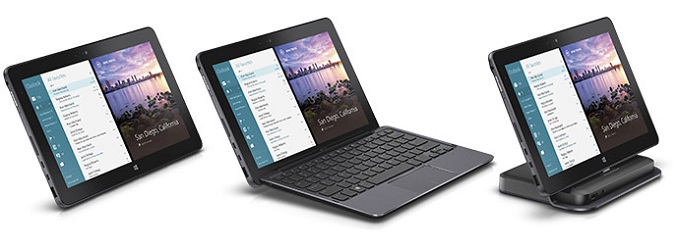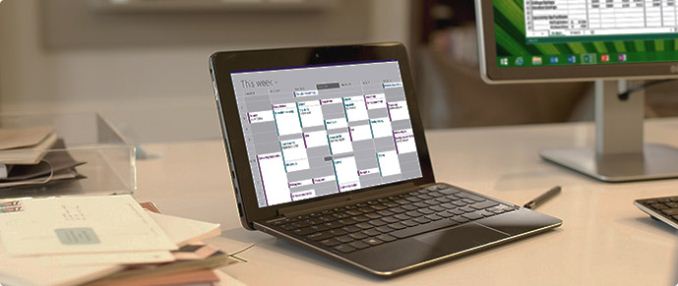Dell Refreshes 11 Inch 7000 Series Tablet With Broadwell
by Brett Howse on November 5, 2014 5:40 PM EST
Dell World is on right now in Austin, and today Dell announced a refresh of the Venue 11 Pro 7000 Series tablet. The 7000 Series is a more expensive, more powerful version of their tablet, and until now has been sold with the Haswell Y series processors. The major change with the newest version of the tablet is that it will be equipped with a Broadwell Core-M processor, which enables it to become fanless.
The 7000 Series is aimed more at the business crowd, with additional features such as optional docking stations, keyboards, stylus, and two-factor authentication with integrated smartcard and fingerprint readers. With the tablet running Core processors instead of Atom, the price is also aimed higher than many other tablets, with a price closer to the Microsoft Surface Pro 3. It does undercut the Microsoft tablet on price though, with a starting price of $699.99.
| Dell Venue Pro 7000 Series | ||||||
| Specifications | ||||||
| CPU | Intel Core-M 5Y10a/5Y70 (Dual-Core 0.8-2.0 GHz/1.1-2.6 GHz) |
|||||
| GPU | Intel HD 5300 | |||||
| RAM | 4-8 GB DDR3L 1600 MHz | |||||
| SSD | 64 to 128 GB | |||||
| Display | 10.8" 1920x1080 HD IPS LCD | |||||
| Battery | 38 Whr | |||||
| Connectivity | Intel Wireless-AC 7265 (802.11ac/BT4.0/NFC) Optional Intel XMM 7160 LTE Modem |
|||||
| Height | 176.4 mm | |||||
| Width | 279.8 mm | |||||
| Depth | 10.75 mm | |||||
| Weight | 733.4g (Wi-Fi) 757.3g (LTE) | |||||
| Price | $699 Starting | |||||
One of the most important parts of a tablet is likely the display, and the Venue Pro 11 7000 Series seems to keep the same 10.8” IPS (the press release says IPS while the tech specs say TN – most likely it is IPS) display from the previous version. Though not the highest resolution tablet display, it still has Full HD resolution which gives it right around 200 pixels per inch. The touch screen has 10-point capacitive touch, and likely has support for the same active stylus option as the previous version.
Powering the new fanless design is the Intel Core-M 5Y10a, with the 5Y70 possibly being offered at a later date. These are both dual-core designs, which also have hyper-threading enabled. Graphics are handled by the integrated Intel HD 5300 GPU. Also included in the package is vPro with the 5Y70, which should help sell the new tablet in the enterprise. Memory options are 4 or 8 GB of LPDDR3-1600, and connectivity is provided by the Intel Dual Band Wireless-AC 7265 chip. This is newer, smaller version of the Wireless-AC 7260 card which is available in the M.2 form factor only. Also available is the Intel XMM 7160 modem which supports 2G/3G/LTE. Storage is either a 64 or 128 GB SSD, and the battery is a 38 Whr model which Dell says should get through the work day – whatever that means.
Other miscellaneous features include a full size USB 3.0 port, Bluetooth 4.0, micro HDMI, NFC, a Sensor Hub (Gyro, G-sensor, Proximity), and a microSD slot which can accept up to 128 GB of extra storage.
The new model is 15 percent thinner than the outgoing version, which is expected with the move to Core-M. Intel did a lot of work to allow these thinner models, and not just the 4.5 watt TDP. If you have missed our previous coverage on this, I will refer you to Ryan’s Broadwell preview.
As this is marketed as a business machine, a lot of the design and focus was on accessories. Dell once again offers a multitude of accessories to allow this design to bridge the gap between a tablet and a PC in the office, with an optional docking station, as well as a snap on keyboard which transforms the tablet into a clamshell laptop. If you need extra battery life, they also have a Mobility Keyboard option which includes a supplemental battery. To specifically target the Healthcare industry, they even have a Healthcare Case which can be fully sanitized. Dell is even offering a Mobile Payment Solution with a 2D barcode scanner and magnetic stripe reader for retail and hospitality customers.
Core-M is just now starting to roll out, and it is great to see the number of new fanless devices which are hitting the market. At just 1.62 lbs, it is a bit heavier than an iPad Air 2, but with the power of a Core CPU. The Dell Venue 11 Pro 7000 Series will be available for purchase on www.dell.com beginning November 11th.
Source: Dell











32 Comments
View All Comments
Brett Howse - Wednesday, November 5, 2014 - link
My guess is it works poorly. The previous one ran Linux fine except for the lack of WiFi, touch, and GPU support.TiGr1982 - Wednesday, November 5, 2014 - link
Indeed, lack of WiFI and touch essentially already makes it useless in its original intended role :)MrSpadge - Thursday, November 6, 2014 - link
You're probalby better off to run that Linux in a VM and let Win take care of the fancy new hardware.TiGr1982 - Wednesday, November 5, 2014 - link
1) I'm just curious how Broadwell-Y is doing there in terms of thermals and practical obtained performance (read: practical frequency range). It would be interesting to know.2) Also, generally it would be interesting to compare Haswell vs Broadwell clock per clock in various benchmarks (around 5-6% improvement is expected according to Intel Broadwell core slide in their Core M presentation), though I guess it won't be possible with these Y parts (at least, with frequencies other than idle 800 MHz); one has to wait for desktop CPUs to fixate the same frequencies for Haswell and Broadwell CPUs on, say, Z97 motherboard and actually do the clock-per-clock comparison.
As an offtop, is there any info on forthcoming Skylake CPU core?
Seems to be no meaningful info regarding Skylake CPU core on the Web as of yet.
TiGr1982 - Thursday, November 6, 2014 - link
Regarding 2): sweclockers just tried to compare Broadwell and Haswell clock-per-clock and got just 3% improvement (not even 5-6% clock-per-clock), if somebody is interested.Wolfpup - Monday, November 10, 2014 - link
Hey, 3% isn't bad if it's basically just a die shrunk Haswell with slightly better GPU. If they can really cram these in systems similar to Atom/ARM systems, that's amazing. (Of course second gen Atom is already pretty amazing, for a tablet chip...not quite sure why AMD isn't getting more design wins though)DanNeely - Wednesday, November 5, 2014 - link
Also of potential interest in that press release; in apparent response to Apple's pricing fo the retina iMac starting at $2500; Dell's cut the launch price for their upcoming 5k monitor from $2500 (initial announcement) to under $2000.GC2:CS - Thursday, November 6, 2014 - link
"At just 1.62 lbs, it is a bit heavier than an iPad Air 2, but with the power of a Core CPU."Whaaaaaat ?
A bit ? It's almost 70% heavier ! Heavier than the original iPad.... It even looks like a "tablet" from the pre-iPad era.
And yes probably it will have a faster SoC because it's intel. But well A8X is a monster and not only that, it's a monster that doesn't need a lot of food....
So how much faster exactly is the core M ? 3-times ? 2-times ? 50% faster ?
What's the sustained performance ?
How well the HD5300 stacks aginst the GX6650 ?
And most importantly does the added performance (if there is some) comes with lower efficiency than A8X ?
And is just the added performance enough to outweigh the crippled formfactors ?
Speedfriend - Thursday, November 6, 2014 - link
How well the HD5300 stacks aginst the GX6650 ?We know the answer to this
Air 2 3D Mark 1.2 Unlimited - 21793
Core M reference tab - 49917
And given Apple never announces TDP it is hard to compare efficiency at the chip level versus overall platform efficiency.
OrphanageExplosion - Sunday, November 9, 2014 - link
That's a poor comparison because 3DMark Physics skews the overall benchmark down significantly. Apple's CPU cores can't cope with that very well: http://www.futuremark.com/pressreleases/understand...